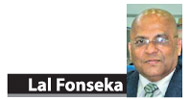Excellence is not what meets the eye!
Lal Fonseka
 The word “effective” to me means quality. Then the question will
arise what quality is. Quality means conformance to requirement when one
discusses on Education. The word “effective” to me means quality. Then the question will
arise what quality is. Quality means conformance to requirement when one
discusses on Education.
In a school, the conformance to requirement is in three folds. As per
our education system, they are knowledge, skills and attitudes. Are our
schools falling in line with these requirements? The whole purpose of
this article is to find solutions to this question.
Students’ discipline
As far as the discipline and the attitudes of our students are
concerned, discipline of our students in general have been deteriorating
day by day. This is a very pathetic situation. It is true that one or
two effective schools take a thoughtful approach towards student
discipline.
 A majority of schools do not care the students’ attitudes and skills.
They do always give priority to the knowledge-based education. Their
main target is to achieve most number of higher grades in the
competitive examinations and display a large board of students’ pictures
that had excelled in such examinations just in front of the school
entrance. Despite these high educational performances it is sad to hear
frequent reports of violent incidents. It has now spread to the big
match arena too. A majority of schools do not care the students’ attitudes and skills.
They do always give priority to the knowledge-based education. Their
main target is to achieve most number of higher grades in the
competitive examinations and display a large board of students’ pictures
that had excelled in such examinations just in front of the school
entrance. Despite these high educational performances it is sad to hear
frequent reports of violent incidents. It has now spread to the big
match arena too.
Consider the following situation: Two schools located in Colombo
which are considered as “sister schools.” Assume that they are
approximately the same size, serve the same community, and the student
populations are identical. However, in one school state controlled
examination scores are low and half the students failed. In the other
school, student examination scores exceed the country average and almost
all students are eligible to enroll the university. Why this difference?
Effective schools
Under these circumstances, we do always label the school which has
done well with examination results as an effective school and the other
school is an in-effective school. Puzzled by such situations all over
the world, researchers have attempted to determine what factors create
successful or effective schools. Several studies have revealed a common
set of characteristics, a five-factor theory of effective schools.
Whatever the findings and conclusions of these researchers, without
any argument any reasonable man will agree that to convert a school in
to an effective school, the first requirement will be to have a proper
discipline among students.
Discipline is the structure that helps the child fit into the real
world happily and effectively. It is the foundation for the development
of the child’s own self-discipline. Effective and positive discipline is
about teaching and guiding children, not just forcing them to obey.
Disciplining children is one of the most important yet difficult
responsibilities of the school authorities and there are no shortcuts.
The hurried pace of today’s competitive examinations can be an obstacle
to effective discipline.
The goal of effective discipline is to foster acceptable and
appropriate behaviour in the child and to raise emotionally mature
adults. A disciplined person is able to postpone pleasure, is
considerate of the needs of others, is assertive without being
aggressive or hostile, and can tolerate discomfort when necessary.
Thus, effective discipline means discipline applied with mutual
respect in a firm, fair, reasonable and consistent way. The goal is to
protect the child from danger, help the child learn self-discipline and
develop a healthy conscience and an internal sense of responsibility and
control. It should also instill values.
Researchers say that effective schools are able, through these five
factors, to promote student achievement with discipline. Let us look at
these classic five factors.
1. Strong leadership
2. A clear school mission
3. A safe and orderly climate
4. Monitoring student progress
5. High expectations
A brief explanation of these five factors theory is analysed below.
Factor 1: Strong leadership
There is a very popular saying that in an effective school, you
cannot have a bad principal and at the same time you cannot have a good
principal in an in-effective school. Without making extra efforts to
analyse the above saying, we have to admit that the prime requirement of
any institution to make it to an effective institution is to have an
effective leadership.
Leadership style of effective principal has been collaborative,
actively seeking faculty participation. Not only does he want his staff
to participate in decision making, but he has to give them the
opportunity to try new things-and even the right to fail.
For example, effective principals allow teachers to learn through
errors. One particular principal whom I know allow teachers to learn a
great deal from their experiences, and he let them try again even when
their first attempt is failed.
The second attempt is a great success. “He sees failure as an
opportunity for change,” One teacher commented. Still other teachers
describe him with superlatives, such as “he is the lifeblood of this
organism” and “the greatest human being I have ever known.” However, in
today’s context, we are hard to hear such beautiful comments.
Researchers say that students make significant achievement gains in
schools in which principals
* Articulate a clear school mission
* Are a visible presence in classrooms and hallways
* Hold high expectations for teachers and students
* Spend a major portion of the day working with teachers to improve
instruction
* Are actively involved in diagnosing instructional problems
* Create a positive school climate
Factor 2: A clear school mission
In effective schools, good principals somehow find time to develop a
vision of what that school should be and to share that vision with all
members of the educational community. Successful principals can
articulate a specific school mission, and they stress innovation and
improvement.
In contrast, less effective principals are vague about their goals
and focus on maintaining the status quo. They make such comments as, “We
have a good school and a good faculty, and I want to keep it that way.”
In our country, a majority of principals are very selfish and plays a
one man-show.
He or she does not care what his or her academic staff has to say. He
or she does not recognise the innovative thinking of them. It is
essential that the principal share his or her vision, so that teachers
understand the school’s goals and all work together for achievement.
Unfortunately, Most of our teachers say that they have either no
contact or infrequent contact with one another during the school day.
In less effective schools, teachers lack a common understanding of
the school’s mission, and they function as individuals charting their
own separate syllabus.
In my opinion, the principal should share his or her vision not only
with teachers but also with parents. When teachers work cooperatively
and parents are connected with the school’s mission, the children are
more likely to achieve educational success with high discipline.
In our school system, whatever the regulations introduced by the
Ministry in barring the Principals collecting money from parents, they
continue to do so without any fear. Because they need to have more and
more social functions involving students sometimes spending huge amount
of money, energy and the most precious time.
Academic successes too are achieved by the students not due to the
efforts of the school. It is very rare if we could find a student who
has done excellently well in an examination without the assistance of
tuition classes.
Factor 3: A safe and orderly climate
Certainly before students can learn or teachers can teach, schools
must be neat and safe. Just a couple of weeks ago, implementing 6S and
3R concepts in 100 schools in the country were concluded under my direct
supervision.
This project was commenced in 2009 and continued for four years.
Unfortunately of these 100 schools, not even a mere 25% were able to
sustain the project which is a very sad situation.
When one considers the amount money, the sponsoring bank spent, the
word one could use is nothing other than “sad.”
An unsafe and untidy school is ineffective. When the class rooms are
un-cleaned and untidy, you cannot expect from students to show their
maximum potentials. Nearly all public school teachers (98 percent) and
most students (93 percent) report that their schools are disorganised
and the environment is messy. Due to these short-comings, the public
considers these schools as lack disciplined.
Factor 4: Monitoring student progress
There is a school located in Jayanthipura, Polonnaruwa. I noticed an
one particular hall is named by using the name of the student who had
obtained the best results of G.C.E (O/L) examination to recognise his
feat.
This name could only be replaced by another student who could break
the existing record. What a beautiful and innovative method this school
has introduced to motivate the students.
In an effective school, students should have a clear sense of how
they are doing in their studies: All students should keep progress
charts in their notebooks.
In a school in the Galle District, teachers had a system of assessing
the individual strengths and weaknesses of their students. Teachers
refer to student folders that contained thorough records of student
scores on standardised tests, as well as samples of classwork, homework
and performance on monthly tests.
Effective schools carefully monitor and assess student progress.
Factor 5: High expectations
In effective schools, teachers hold high expectations that students
can learn, and they translate these expectations into teaching
behaviours.
They set objectives, work toward mastery of those objectives, spend
more time on instruction, and actively monitor student progress. They
are convinced that students can succeed.
Do high expectation work if students do not believe they exist?
Probably not, and that is too often the case. As per the recent
research, while a majority of secondary school principals believe that
their schools hold such expectations for their students, only 39 percent
of teachers believe this to be true and even more discouraging.
Only one in four students believe their school holds high
expectations for them. We need to do a better job of communicating these
expectations to students, and making certain that these expectations
truly challenge students.
When the teachers hold high expectations for their own performance,
the entire school will benefit. When striving for excellence, these
teachers felt that no matter how well a class was taught, next time it
could be taught better. |





